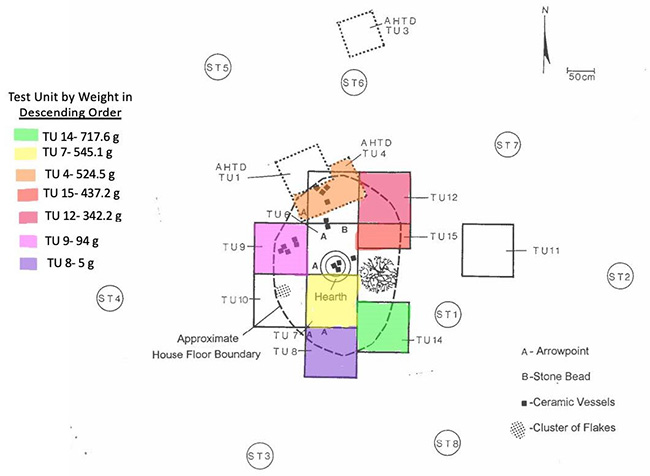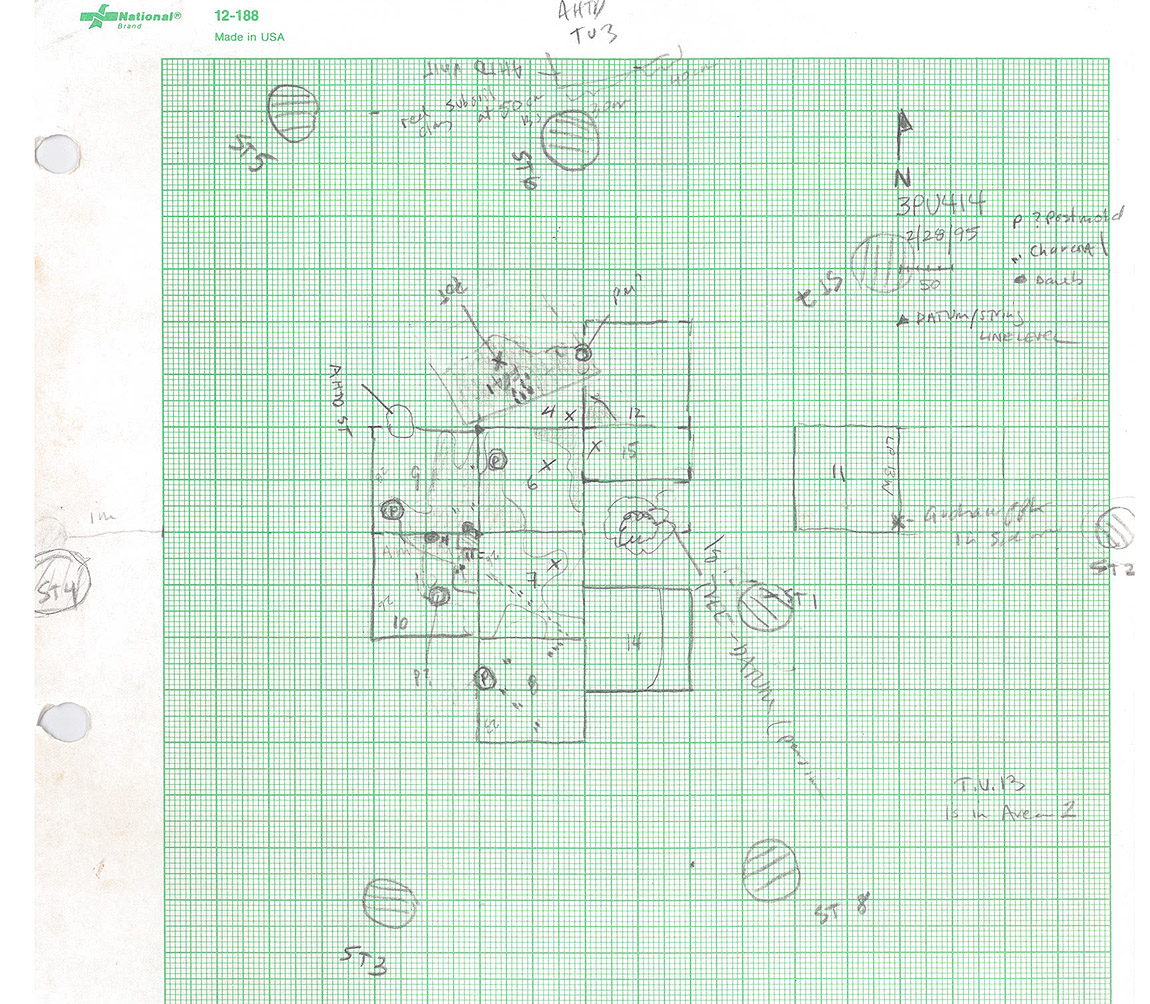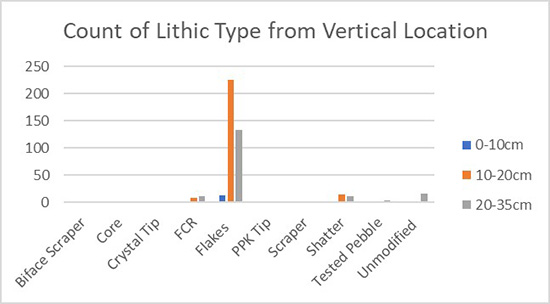Natalie Lybbert, Abigail Reece, Austin Davis, Madelaine Thomas, Alice Palencia, Bethany Green, and Jessica Kowalski
Feature of the Month - June 2022

Dark Hollow is a multi-component site located outside of Little Rock near the juncture of major physiographic regions in Arkansas, including the Ouachita Mountains, the Mississippi Embayment, and the Arkansas River Valley. Although Middle to Late Archaic stone tools were found across the site, a concentration of shell-tempered ceramics was found during initial testing by the Arkansas Highway and Transportation Department in August and September of 1994 (Miller 1994), which led to a more thorough excavation of the site by Spears Professional Environmental & Archeological Research Service, Inc. in 1995 (Spears and Baker 1995). Excavations exposed Feature 1, a single, burned house structure. Several partial vessels were found on the floor of the structure, along with portions of a charcoal beam. Radiocarbon samples from charcoal date the structure to the fifteenth century or the Late Mississippi period (notes on file, Arkansas Archeological Survey).
A group of undergraduate students enrolled in the Spring 2022 Approaches to Archeology course at the University of Arkansas (ANTH 3023) examined a sample of artifacts from the house feature as part of a final project. Students examined the field records (Bethany Green), ceramics (Natalie Lybbert and Austin Davis), debitage (Abigail Reece), and the distribution of charcoal (Madelaine Thomas and Alice Palencia) to characterize the household deposits.

The house boundary was determined by the presence of burned clay and compacted soil, covering an area approximately 4-x-3 m2 in size. Although charcoal was scattered across the floor of the structure, it was most heavily concentrated in the southeast corner of the house (Figure 1). No wall trenches and only a few ephemeral post molds were recorded in the field (Figure 2), indicating the house may have been open on some sides, or arbor-style. A central hearth was exposed, Feature 2. The hearth was 60 cm in diameter and horseshoe-shaped. Several partial ceramic vessels were recovered from the hearth as well as a quartz crystal.
A total of 172 sherds were found inside the structure, including examples of Mississippi Plain (n=76). A total of 84 sherds belonged to vessels that had applique strips around the outer shoulder of otherwise simple or slightly restricted shell-tempered bowls. Two of these appliqué vessels also had rim effigies of undetermined shape. Of these two appliqué/effigy vessels, one also reflected pinched ridges in a curvilinear design which is atypical for the region (Figure 3a). Burnished, finely shell-tempered sherds (Bell Plain) were also recovered from the hearth area of the house. However, the location of the majority of the sherds were in the north/northwest area of the house floor. There was possibly vessel storage in this area that would have burned when the house burned.
Ceramics recovered from the floor of the house represent a minimum of seven partial vessels, including simple bowls, and two possible carinated jars. Simple bowls had orifice diameters ranging from 18 cm to 31 cm in size, or were medium to large and likely used to prepare and serve food. It is possible that storage jars were removed from the house before it was burned, accounting for the lack of jars in the ceramic assemblage. However, when considering the complete vessel assemblage, including bowls with appliqué strips and effigies, an unusual decorative technique in the form of curvilinear ridge pinching, and some burnishing, it is possible the assemblage was special-purpose and does strictly represent domestic or residential refuse.


A sample of debitage was examined from the central portion of the house, specifically from test units 6 and 7. The lithic assemblage was dominated by small chert flakes recovered from between 10–20 cm beneath the ground surface or just above the house floor (Figure 4). Novaculite, quartz, and sandstone were also identified in the assemblage indicating access to non-local stone. There was only a single core identified in the sample, indicating that early stage reduction was not taking place inside the house intensively.
In summary, the fifteenth century structure from Dark Hollow has some unusual characteristics, including a lack of wall trenches more typical of Mississippian houses in the Mississippi River floodplain, a ceramic assemblage dominated by medium to large bowls with appliqué strips, and a lithic assemblage that indicates tool re-sharpening rather than primary reduction and access to nonlocal stone. The presence of a central hearth suggests a permanent structure, although perhaps more open in design. Furthermore, the distribution of charcoal, including some partially intact beams (Figure 5), indicates a substantial roof element. Feature 1 at Dark Hollow demonstrates variability in Mississippian houses in Arkansas, and suggests that different site types with different types of architectural elements may characterize the Arkansas River Valley landscape.

Works Cited
Miller, John E. III
1994 A Cultural Resources Survey of Arkansas Highway and Transportation Job Number R60138, Springhill Drive Interchange (NLR) (I-40), Pulaski County, Arkansas Report on file, Environmental Division, Arkansas State Highway & Transportation Department, Little Rock.
Phillips, Philip
1970 Archaeological Survey in the Lower Yazoo Basin, Mississippi, 1949-1955: Part One. Papers of the Peabody Museum of Archaeology and Ethnology. Harvard University, Cambridge.
Spears, Carol S. and C. Michael Baker
1995 Management Summary: Significant Testing at 3PU414. Pulaski County, Arkansas. Report on file, Arkansas Archeological Survey, Fayetteville.
Feature of the Month Series
Archeological features are elements or structures that are nonportable or cannot be easily removed from a site (such as a wall or a post hole). Archeologists document archeological features extensively in the field to record what will otherwise be destroyed in the process of excavation. The records of these features are often all that is left at the end of an excavation. Excellent record keeping is necessary for these features to provide insight into the archeological record and site formation.
In this series, we present interesting and important archeological features that have helped archeologists to better or more fully understand the sites on which they were working. New features will be added monthly. Find the list of features here.
